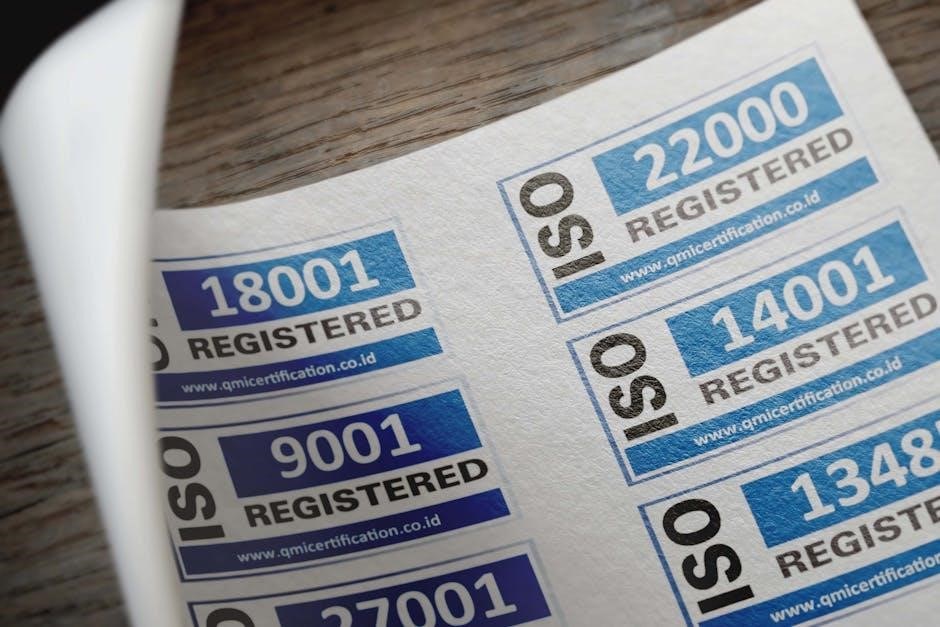ISO 13485:2016 is the third edition of the international standard for medical devices‚ replacing the 2003 version․ It outlines requirements for quality management systems‚ ensuring compliance with regulatory demands and customer expectations․ The standard is available as a PDF‚ providing detailed guidelines for organizations involved in the development‚ production‚ and distribution of medical devices․ It emphasizes process interactions‚ risk management‚ and continuous improvement to maintain product quality and safety․
Overview of ISO 13485:2016
ISO 13485:2016 is the third edition of the international standard for medical device quality management systems․ It provides requirements for organizations to ensure compliance with regulatory and customer expectations․ The standard replaces the 2003 version and is available as a free PDF download‚ offering detailed guidance on process management‚ risk assessment‚ and continuous improvement․ It focuses on maintaining product safety and quality‚ aligning with regulatory demands and industry best practices for medical devices globally․
Importance of ISO 13485:2016 for Medical Devices
ISO 13485:2016 is crucial for ensuring quality and regulatory compliance in medical devices․ It provides a framework for organizations to demonstrate their ability to consistently meet customer and regulatory requirements․ By following this standard‚ companies can enhance product safety‚ reduce risks‚ and gain market access․ The PDF document is widely available‚ offering detailed guidelines for implementing effective quality management systems tailored to the medical device industry‚ ensuring trust and reliability in global markets․

Key Features of ISO 13485:2016
ISO 13485:2016 provides a robust quality management system for medical devices‚ emphasizing regulatory compliance‚ risk management‚ and customer satisfaction‚ ensuring safety and effectiveness․
Quality Management System Requirements
ISO 13485:2016 outlines specific QMS requirements tailored for medical devices‚ focusing on safety‚ efficacy‚ and regulatory compliance․ It mandates a structured approach to documentation‚ record-keeping‚ and process control․ Organizations must establish clear quality objectives‚ define roles‚ and ensure continuous improvement․ The standard emphasizes risk management‚ corrective actions‚ and supplier controls‚ ensuring adherence to global medical device regulations․ Compliance with these requirements is critical for certification and maintaining trust in the healthcare industry․
Regulatory Compliance and Certification
ISO 13485:2016 ensures regulatory compliance by aligning quality management systems with global medical device regulations․ Certification involves audits verifying adherence to the standard‚ including documentation‚ risk management‚ and corrective actions․ Achieving certification demonstrates an organization’s commitment to meeting regulatory requirements‚ enhancing credibility and market access․ It also facilitates compliance with FDA‚ EU MDR‚ and other international standards‚ ensuring safe and effective medical devices for patients worldwide․
Updates from the 2003 Version
ISO 13485:2016 introduces significant updates‚ including enhanced risk management‚ alignment with global regulatory requirements‚ and improved clarity․ It emphasizes a more proactive approach to quality management‚ with updates to documentation‚ corrective actions‚ and supplier control․ The standard now aligns with the EU Medical Devices Regulation (MDR) and other international standards․ These updates ensure the standard remains relevant and effective for modern medical device manufacturing and regulatory compliance․

Why ISO 13485:2016 is Essential
ISO 13485:2016 is critical for medical device manufacturers‚ ensuring compliance with global regulations‚ enhancing product safety‚ and improving quality management systems to meet customer expectations effectively․
Enhanced Customer Satisfaction
ISO 13485:2016 ensures medical devices meet regulatory and quality standards‚ fostering customer trust and loyalty․ By aligning processes with customer needs‚ manufacturers deliver safer‚ more reliable products․ The standard emphasizes continuous improvement‚ enabling organizations to address feedback and enhance user satisfaction․ This focus on quality and compliance translates to higher customer confidence‚ making ISO 13485:2016 essential for maintaining a strong reputation in the medical device industry․
Improved Regulatory Compliance
ISO 13485:2016 ensures alignment with global regulatory requirements for medical devices‚ reducing the risk of non-compliance․ The standard emphasizes a systematic approach to quality management‚ enabling organizations to meet stringent regulatory demands; By focusing on risk management and documentation‚ it simplifies compliance with FDA‚ EU MDR‚ and other regulatory bodies․ This adherence ensures safer products‚ builds trust‚ and facilitates market access‚ making ISO 13485:2016 a cornerstone for regulatory readiness in the medical device industry․
Competitive Advantage in the Market
ISO 13485:2016 certification enhances your organization’s market competitiveness by demonstrating adherence to rigorous quality and regulatory standards․ It builds credibility‚ fostering trust among clients and stakeholders․ Certified companies often gain preferential treatment in tenders and partnerships․ Compliance with the standard also ensures alignment with global market requirements‚ making it easier to expand internationally․ By streamlining processes and reducing errors‚ ISO 13485:2016 helps organizations deliver high-quality products‚ strengthening their reputation and market position․
ISO 13485:2016 and FDA Regulations
ISO 13485:2016 aligns with FDA regulations‚ particularly 21 CFR‚ ensuring compliance with U․S․ requirements for medical devices․ It streamlines the regulatory process‚ fostering confidence in product safety and quality․
Mapping to U․S․ FDA 21 CFR
ISO 13485:2016 aligns with U․S․ FDA regulations‚ specifically 21 CFR‚ facilitating compliance with medical device requirements․ The standard supports FDA expectations for quality systems‚ design controls‚ and risk management․ By adhering to ISO 13485:2016‚ organizations can meet both international and U․S․ regulatory demands‚ ensuring product safety and efficacy․ This alignment streamlines compliance processes‚ making it easier for manufacturers to access global markets while maintaining FDA standards․
Ensuring Compliance with Regulatory Requirements
ISO 13485:2016 provides a robust framework to ensure compliance with regulatory requirements for medical devices․ It emphasizes a quality management system tailored to meet stringent regulations globally․ The standard requires organizations to maintain detailed documentation‚ conduct regular audits‚ and implement corrective actions․ By aligning with ISO 13485:2016‚ companies can consistently meet regulatory demands‚ reducing risks and ensuring the safety and effectiveness of medical devices throughout their lifecycle․

How to Implement ISO 13485:2016
Understand the standard‚ establish a QMS‚ conduct a gap analysis‚ develop procedures‚ train staff‚ implement controls‚ and prepare for audits and certification․
Step-by-Step Implementation Guide
Begin by understanding ISO 13485:2016 requirements‚ then establish a Quality Management System tailored to your organization․ Conduct a gap analysis to identify areas needing improvement․ Develop detailed procedures‚ train employees‚ and implement necessary controls․ Regularly review processes to ensure compliance and prepare for internal and external audits․ Finally‚ seek certification from an accredited body to demonstrate adherence to the standard․ Accessing the ISO 13485:2016 PDF from official sources ensures accurate guidance throughout the process․
Key Processes and Interactions
ISO 13485:2016 emphasizes management responsibility‚ resource management‚ and product realization processes․ It integrates risk management throughout the quality system‚ ensuring compliance with regulatory requirements․ Key interactions include design and development‚ production‚ and post-market surveillance․ Effective documentation and record control are critical․ Training and internal audits ensure process adherence․ These processes work together to maintain quality‚ safety‚ and regulatory compliance for medical devices‚ aligning with the standard’s requirements outlined in the ISO 13485:2016 PDF․
Training and Internal Audits
ISO 13485:2016 requires organizations to conduct regular training and internal audits to ensure compliance․ Training programs focus on quality management principles‚ regulatory requirements‚ and process-specific skills․ Internal audits assess the effectiveness of the QMS‚ identifying gaps and fostering continuous improvement․ These activities ensure staff are competent and processes align with the standard‚ preparing for successful certification audits and maintaining ongoing compliance with ISO 13485:2016 requirements․

ISO 13485:2016 vs․ ISO 9001
ISO 13485:2016 focuses on medical devices with strict regulatory compliance‚ while ISO 9001 is a general QMS standard․ Key differences include industry-specific requirements and risk management․
Differences in Quality Management Systems
ISO 13485:2016 is specifically designed for medical devices‚ focusing on regulatory compliance and safety‚ while ISO 9001 is a general QMS standard for all industries․ Key differences include stricter requirements for risk management‚ design controls‚ and documentation in ISO 13485․ It emphasizes compliance with medical device regulations‚ such as FDA and EU MDR‚ whereas ISO 9001 focuses on customer satisfaction and continuous improvement․ ISO 13485 also requires more detailed documentation and audit processes to ensure compliance with industry standards;
Specific Requirements for Medical Devices
ISO 13485:2016 includes specific requirements for medical devices‚ such as design validation‚ risk management‚ and documentation․ It emphasizes compliance with regulatory standards throughout the product lifecycle․ Key aspects include strict controls for design‚ production‚ and post-market surveillance․ The standard also requires traceability‚ corrective actions‚ and a focus on patient safety․ These requirements ensure that medical devices meet global regulatory expectations and are safe for use․ Compliance with ISO 13485:2016 is critical for manufacturers in the medical device industry;
Benefits of ISO 13485:2016 Certification
ISO 13485:2016 certification enhances credibility‚ ensures regulatory compliance‚ improves product quality‚ and facilitates global market access‚ essential for medical device manufacturers seeking trust and market expansion․
Increased Credibility and Trust
ISO 13485:2016 certification significantly enhances a company’s credibility and trustworthiness in the medical device industry․ It demonstrates a commitment to meeting stringent quality and safety standards‚ ensuring patient safety and regulatory compliance․ Third-party verification of the quality management system builds confidence among customers‚ regulators‚ and stakeholders․ This certification also strengthens relationships with suppliers and partners‚ fostering collaboration and long-term business growth․ It positions the organization as a reliable and responsible player in the global market‚ adhering to internationally recognized best practices․
Access to Global Markets
ISO 13485:2016 certification opens doors to global markets by ensuring compliance with international medical device regulations․ It is recognized in Europe‚ North America‚ Asia‚ and beyond‚ facilitating market entry․ Companies adhering to this standard gain a competitive edge‚ as it aligns with regulatory requirements worldwide․ This certification is often a prerequisite for exporters‚ enabling them to meet diverse country-specific standards․ Achieving ISO 13485:2016 certification simplifies the process of expanding into new international markets‚ driving business growth and global presence․
Improved Process Efficiency
ISO 13485:2016 enhances process efficiency by streamlining quality management systems tailored for medical devices․ It reduces waste‚ improves productivity‚ and ensures compliance with regulatory requirements․ The standard’s focus on risk management and continuous improvement helps organizations identify inefficiencies and optimize workflows․ By implementing these processes‚ companies can achieve higher operational consistency‚ reduce errors‚ and improve product quality․ This leads to faster time-to-market and better customer satisfaction‚ making ISO 13485:2016 a cornerstone for efficient medical device manufacturing․

Challenges in ISO 13485:2016 Implementation
ISO 13485:2016 enhances process efficiency by implementing streamlined workflows‚ reducing operational redundancies‚ and fostering a culture of continuous improvement‚ leading to optimized resource utilization and higher productivity․
Understanding Regulatory Requirements
ISO 13485:2016 presents challenges in interpreting complex regulatory demands‚ especially for organizations new to medical device standards․ The standard aligns with FDA and EU MDR requirements‚ requiring precise documentation and strict controls․ Navigating these demands can be daunting‚ as non-compliance risks are high․ Organizations must invest in training and internal expertise to ensure alignment with global regulations‚ fostering a culture of compliance and continuous improvement to meet evolving standards effectively․
Resource Allocation and Training
Implementing ISO 13485:2016 requires strategic resource allocation to ensure compliance with quality management systems․ Organizations must dedicate sufficient funds‚ time‚ and personnel to meet the standard’s demands․ Training is critical‚ as staff must understand the regulations and processes․ Internal training programs‚ workshops‚ and audits help maintain expertise and readiness for certification․ Proper allocation ensures efficient use of resources‚ while continuous training fosters a culture of quality and compliance‚ essential for long-term success in the medical device industry․
Maintaining Compliance Over Time
Maintaining compliance with ISO 13485:2016 requires ongoing effort and monitoring․ Regular internal audits ensure adherence to quality management systems‚ while documentation control prevents deviations․ Training programs keep employees updated on regulatory changes‚ fostering a culture of compliance․ Continuous improvement initiatives and risk management strategies help organizations stay aligned with the standard․ Over time‚ consistent oversight and adaptability to evolving regulations ensure sustained compliance‚ safeguarding the organization’s reputation and operational efficiency in the medical device industry․

ISO 13485:2016 Transition from 2003
Transitioning from ISO 13485:2003 to 2016 involves understanding updated requirements‚ enhanced risk management‚ and improved documentation controls․ Utilize free PDF guides for a smooth transition process online․
Key Changes and Updates
The transition from ISO 13485:2003 to 2016 introduced significant updates‚ including enhanced risk management‚ improved documentation controls‚ and stronger alignment with global regulatory requirements․ The 2016 version emphasizes a more robust quality management system tailored for medical devices‚ ensuring compliance with updated regulatory expectations․ These changes reflect advancements in technology and industry practices‚ providing clearer guidelines for manufacturers to meet current standards effectively․
Impact on Existing Quality Management Systems
The transition to ISO 13485:2016 requires existing systems to adapt to new requirements‚ potentially disrupting current processes․ Manufacturers must reassess and update their quality management systems to align with the updated standard․ This may involve revising documentation‚ procedures‚ and training programs․ While the changes enhance compliance and efficiency‚ they also demand significant time and resources to implement effectively‚ ensuring continued conformity and market acceptance of medical devices․

ISO 13485:2016 Training and Certification
ISO 13485:2016 training programs are essential for understanding the standard’s requirements․ They cover regulatory compliance‚ quality management‚ and audit preparedness‚ ensuring organizations meet certification standards effectively․
Available Training Courses and Resources
Various training courses and resources are available to help professionals master ISO 13485:2016․ These include online webinars‚ workshops‚ and e-learning modules․ Free downloadable resources‚ such as the ISO 13485:2016 PDF‚ provide comprehensive insights into quality management systems for medical devices․ Training programs often cover topics like regulatory compliance‚ risk management‚ and internal audits․ These resources are designed to assist organizations in achieving certification and maintaining adherence to the standard․
Skills for Internal Process Audits
Internal process audits for ISO 13485:2016 require specific skills‚ including a deep understanding of regulatory requirements and the ability to evaluate compliance․ Auditors must be proficient in reviewing documentation‚ identifying non-conformities‚ and ensuring corrective actions are implemented․ Strong analytical and communication skills are essential for effective auditing․ Training programs often emphasize these competencies‚ enabling teams to maintain compliance and improve the overall quality management system․

Future of ISO 13485:2016
The future of ISO 13485:2016 likely includes updates to align with emerging medical technologies and global regulatory changes․ Expect enhanced focus on risk management and innovation․
Expected Revisions and Updates
Future revisions of ISO 13485:2016 may focus on integrating new technologies‚ such as AI and digital health solutions․ Updates could address evolving regulatory requirements and harmonization with other standards․ The standard might expand to cover emerging risks like cybersecurity in medical devices․ These changes aim to enhance patient safety and streamline compliance processes․ Regular reviews ensure the standard remains relevant‚ supporting innovation while maintaining rigorous quality and safety expectations for medical devices globally․
Adoption and Global Trends
ISO 13485:2016 has seen rapid adoption globally‚ particularly in Europe‚ North America‚ and Asia․ Many medical device manufacturers prioritize certification to meet regulatory demands and compete internationally․ Smaller companies are also embracing the standard to demonstrate compliance and credibility․ The trend highlights a growing emphasis on quality and safety in the medical device industry․ Its adoption is further driven by the need for harmonization with local regulations and its integration into broader quality management systems․

How to Obtain ISO 13485:2016 PDF
The ISO 13485:2016 standard can be purchased directly from ISO’s official website or authorized distributors like ANSI and BSI․ Free downloads are not officially available․
Free Download Options and Resources
Accessing ISO 13485:2016 for free is challenging as it is a paid standard․ However‚ some national standards bodies may offer it as part of their collections․ Websites like ResearchGate or Academia․edu might have shared copies‚ though authenticity should be verified․ University libraries with subscriptions could provide access․ Always ensure downloads are from reputable sources to avoid legal issues and maintain document accuracy․ Official sources are recommended for compliance and reliability․
Official Sources for the Standard
The ISO 13485:2016 standard can be purchased directly from the ISO website or through authorized distributors like ANSI‚ BSI‚ or DIN․ These sources provide the official PDF version‚ ensuring authenticity and compliance․ National standards bodies also offer the document‚ often with local language options․ Purchasing from these official channels guarantees access to the most accurate and up-to-date version‚ avoiding risks associated with unofficial or pirated copies․
Global Adoption of ISO 13485:2016
ISO 13485:2016 has been widely adopted globally‚ ensuring compliance with medical device regulations․ Many countries and companies rely on it as a trusted benchmark for quality management․
Industry-Wide Implementation
ISO 13485:2016 is widely implemented across the medical device industry‚ ensuring compliance and consistency․ Many manufacturers adopt it to meet regulatory expectations and improve quality management systems․ The standard is particularly popular in the medical device‚ pharmaceutical‚ and biotechnology sectors․ Its adoption facilitates global market access and enhances credibility․ Companies often integrate the standard into their operations to streamline processes and ensure product safety․ Training programs and resources are widely available to support effective implementation across industries․
Case Studies and Success Stories
Several companies have successfully implemented ISO 13485:2016‚ achieving improved compliance and efficiency․ For example‚ a leading medical device manufacturer reduced non-compliance issues by 40% after certification․ Another company enhanced its global market presence by aligning with the standard․ These success stories demonstrate how ISO 13485:2016 fosters a culture of quality and regulatory adherence‚ driving business growth and customer trust․ Real-world examples highlight the practical benefits of adopting the standard in the medical device industry․
